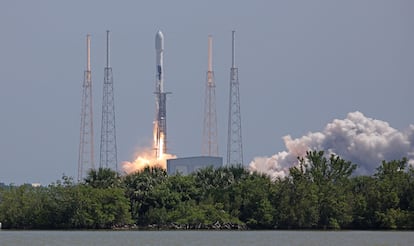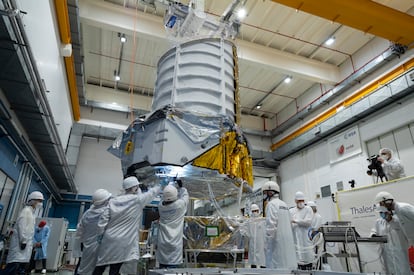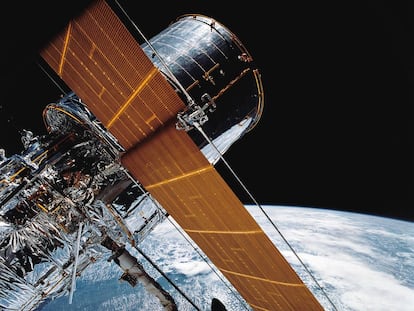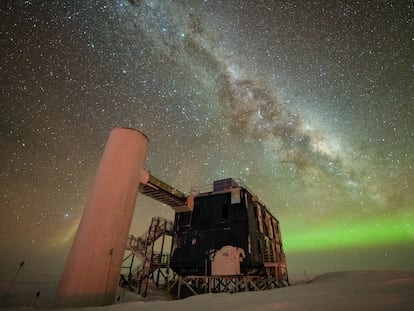‘Euclid’, the European space telescope that will open a window to the dark universe, blasts off successfully
The launch from Cape Canaveral, with a SpaceX rocket, kicks off a mission to study the great enigmas of the universe from a spot 1.5 million kilometers from Earth

Euclid, the European Space Agency’s (ESA) new telescope, is now flying towards its destination in space, from where it will help us understand the expansion of the universe. This marks the beginning of the crucial stage of a project that has been 10 years in the making, with an investment of more than €1.4 billion ($1.5 billion). Its launch, by the U.S. company SpaceX, took place today, according to schedule, at 11.12 (local time) from Cape Canaveral (Florida).
Long gone is French Guyana, from where the mission was originally to be launched using Russian rockets, back when ESA and its Russian counterpart were working in unison. When war broke out in Ukraine, Russia withdrew its personnel, and ESA contracted the services of SpaceX. Billionaire Elon Musk’s company has used a Falcon 9 rocket to send the more than two tons that make-up Euclid into space orbit around the so-called second Lagrange point, 1.5 million kilometers from Earth. The month-long journey will lead to the operational phase, which will last six years.

Euclid will be vital in unraveling one of the most important enigmas of modern astrophysics: the influence of the dark universe on the matter we know. The latter, of which all living things are made, as well as the Earth, the Sun and the rest of the planets and stars, constitutes only 5% of the universe. The remaining 95% is the so-called dark universe, composed of dark matter (25%) and dark energy (70%). Although it is invisible, hence its name, it is important to study this universe because it affects what we can see. Dark matter causes the matter around it to come together, and dark energy causes the matter in the universe to separate faster and faster. In other words, dark matter acts as a kind of cosmic glue, and dark energy as its solvent.
The antagonism between these two opposing forces has shaped the history of the universe since its very origins. Initially, the influence of dark matter prevailed, and as a result, visible matter was grouped into formations that still persist, such as clusters of galaxies. But now it is dark energy that is dominant, and these same clusters are moving away from each other at an accelerating pace. Euclid will try to unravel this puzzle: how did this struggle between dark matter and dark energy develop, and how has it affected the expansion of the universe over the past 10 billion years?
Euclid is named after the Greek mathematician Euclid of Alexandria, who lived around 300 BC and is considered the father of geometry. Since the density of matter and energy are related to the geometry of the universe, the space telescope that will investigate dark matter and dark energy was named in his honor.
🚀Go #ESAEuclid!👋 https://t.co/zrb9TRj66e
— ESA (@esa) July 1, 2023
The telescope will map one third of the sky to create the largest map of the universe ever made, including the position and shape of a large number of galaxies, some of them very distant. Euclid is equipped with two high-tech instruments: one for infrared light (which will be used to determine how far away each galaxy is) and one for visible light (which will show its position and shape). The mission is a technical feat, as Guillermo Buenadicha, ESA’s science operations coordinator, explains: “In order to determine the shape of galaxies with the required precision, Euclid will have to focus on the same point in space for long periods (more than 700 seconds) with an exquisite precision of less than 25 milliseconds of arc. It would be the equivalent of a person keeping a laser pointed at a two-euro coin, located a 100 kilometers away, while floating in a swimming pool.”
Euclid’s instruments, when observing from space, will generate images with a sharpness far superior to those obtained with ground-based telescopes, which are clouded by the atmosphere. It has fundamental advantages even compared to other space telescopes: it will cover a much wider area (although with less detail) than the James Webb, one of the most accurate telescopes of the last decade. These characteristics make it ideal not only for its primary mission, but also for observing asteroids as yet unknown. Bruno Altieri, ESA scientist in charge of the Euclid archive, believes that the impact of the project will be decisive: “With these data on billions of galaxies, Euclid is expected to revolutionize many fields of astronomy.”
With the launch of the new European space telescope, humankind is getting closer to realities it has so far only grazed. Although invisible, dark matter and dark energy make up the bulk of everything around us, and we must shed light on them if we are to understand the universe in which we live. Euclid takes a step in this direction and, along the way, reminds us of the immensity of what we have yet to discover.
Sign up for our weekly newsletter to get more English-language news coverage from EL PAÍS USA Edition
Tu suscripción se está usando en otro dispositivo
¿Quieres añadir otro usuario a tu suscripción?
Si continúas leyendo en este dispositivo, no se podrá leer en el otro.
FlechaTu suscripción se está usando en otro dispositivo y solo puedes acceder a EL PAÍS desde un dispositivo a la vez.
Si quieres compartir tu cuenta, cambia tu suscripción a la modalidad Premium, así podrás añadir otro usuario. Cada uno accederá con su propia cuenta de email, lo que os permitirá personalizar vuestra experiencia en EL PAÍS.
¿Tienes una suscripción de empresa? Accede aquí para contratar más cuentas.
En el caso de no saber quién está usando tu cuenta, te recomendamos cambiar tu contraseña aquí.
Si decides continuar compartiendo tu cuenta, este mensaje se mostrará en tu dispositivo y en el de la otra persona que está usando tu cuenta de forma indefinida, afectando a tu experiencia de lectura. Puedes consultar aquí los términos y condiciones de la suscripción digital.
More information
Archived In
Últimas noticias
Most viewed
- Alain Aspect, Nobel laureate in physics: ‘Einstein was so smart that he would have had to recognize quantum entanglement’
- Mexico’s missing people crisis casts a shadow over World Cup venue
- Why oil has been at the center of Venezuela-US conflicts for decades
- Trump clarifies who is ultimately in charge in Venezuela: ‘Me’
- Mexico seeks to shore up its defenses following US incursion in Venezuela










































